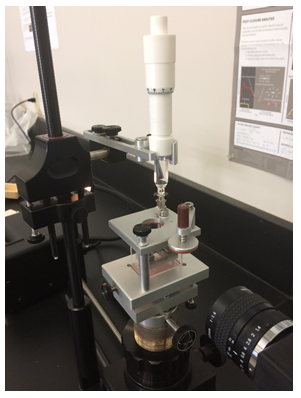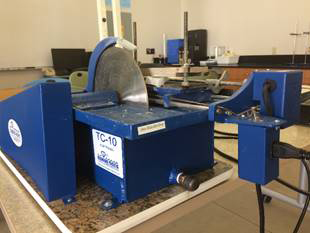Reports: UNI556259-UNI5: Mechanistic Modeling of Wetting Behavior of Complex Rock/Oil/Water Systems for Estimating Rupture Disjoining Pressure
Dayanand Saini, PhD, California State University, Bakersfield
During Year 1 (September 1, 2016 to August 31, 2017), following research activities were performed.
Procurement of contact angle goniometer with environmental fixture:
Initially, it was planned that existing VCA optima contact angle apparatus that was donated by the U.S. Department of Energy to the university, would be customized to evaluate rock/oil/water systems chosen for investigation in the present study. However, principal investigator (PI) was able to secure industry support to procure a brand-new Ramé-hart Model 500 Advance contact angle goniometer/tensiometer (Figure 1) with environmental fixture (Figure 2). The instrument arrived in mid-March.
Figure 1: Ramé-hart Model 500 Contact angle goniometer with environmental fixture (A: light source; B: environmental fixture; C: video camera; D: computer for image processing and analysis).
Figure 2: Environmental fixture (including a quartz cell and liquid drop dispensing syringe) for facilitating ambient condition contact angle and interfacial tension measurements for rock/oil/water and oil/water systems, respectively.
Procurement of slab/trim saw and XP 8 grinder, lapper, and polisher:
Instead of relying on commercially prepared samples of representative rock mineral surfaces (quartz and calcite) for use in proposed experiments, it was decided to develop in-house capability for preparing custom rock mineral surfaces. For this, a slab/trim saw (Figure 3) and a grinder/polisher (Figure 4) were purchased using external funding provided by the industry. These machines have enabled PI and student researchers to cut the quartz and calcite mineral surfaces in desired size and shape and polish them to a satisfactory smoothness.
Figure 3: Slab/trim saw
Figure 4: Grinder/polisher
Preliminary drop volume alteration (increase/decrease) method based contact angle experiments:
In Year 1, preliminary drop volume alteration (increase/decrease) method based contact angle experiments were performed for glass/n-decane/deionized water and quartz/n-decane/deionized water systems. These preliminary experiments have provided the research team an opportunity to test the functioning of Ramé-hart Model 500 Advance contact angle goniometer/tensiometer with environmental fixture and to develop and refine the experimental protocol needed to mechanistically model the wetting behavior of complex rock/oil/water systems via measurements of dynamic water-receding and water-advancing contact angles. The results obtained so far are shown below in Figures 5 & 6.
In these experiments, first a small sessile drop of n-decane was formed on the given surface (glass or quartz) immersed in deionized water. The measured pH of deionized water at laboratory conditions was found to be 6.8. It is noted here that due to preliminary nature of these experiments, no efforts were made to quantify the surface roughness.
Figure 5: Drop volume alternation (increase/decrease) method based contact angle (water-receding and water-advancing) measurements for glass/n-decane/deionized water system
Then, fresh decane drop was brought in contact with already formed drop to increase the drop volume. This stepwise gradual increase in drop volume was made at a time interval ranging from 5 min to 15 min. At each drop volume increase step, both dynamic water-receding contact angle and contact line length were measured. For this, a digital on-screen ruler capable of measuring dimensions and angles was used.
After providing an equilibrium time of 1 hour to the largest size sessile drop formed with the rock surface, drop volume was gradually reduced in stepwise manner. Again, a time interval of 5 min to 15 min was used in two consecutive drop volume reduction steps.
Further data analysis and interpretation of the collected data is in progress.
Figure 6: Drop volume alternation (increase/decrease) method based contact angle (water-receding and water-advancing) measurements for quartz/n-decane/deionized water system
Procurement of two dimensional (2D) physical pore network model (microfluidic porous media chip) and accessories:
In Year 1, PI spent significant amount of time for finding a suitable solution for proposed construction of 2D pore network models. After weighing different options, it was determined that compared to in-house construction of 2D physical pore network models, use of microfluidic porous media chips would be a rapid and cost-effective way for comparing the mechanistic modeling results with the pore-level wetting behavior observed in planned displacement (primary drainage and secondary imbibition) experiments. For setting up the experimental setup needed to perform displacement experiments, two porous media chips (offered by Dolomite Microfluidics), digital microfluidic flow, pressure sensors, and a digital pressure and flow readout unit (offered by Elveflow) have been procured.
In Year 2, micro syringe pumps and other accessories will be procured. Once, all the desired components become available, experimental setup will be put together for performing carefully designed displacement experiments. Digitally acquired images of individual pores will be analyzed for evaluating the wetting behavior of individual pores. These results will be compared with wetting behavior observed in mechanistic modeling (drop volume alteration) experiments.
Figure 7: Porous media chip offered by Dolomite Microfluidics (A), microfluidic flow sensor (B), digital pressure and flow readout unit (C), and two microfluidic pressure sensors (D)
Scientific educational impact:
Over the summer, PI provided necessary training to selected undergraduate student researchers on various equipment, instruments, measurement procedures and safety, cleaning, and experimental protocols. These trainings have enabled the student researchers to learn about various steps involved in the preparation of representative rock samples and synthetic brines of desired standard and quality in the laboratory. The student researchers have assisted the PI in performing preliminary contact angle experiments. The hands-on experience gained by the student researchers in the laboratory is expected to provide them detailed insights of the phenomena of pore-level wetting behavior of complex rock/oil/water systems and thus improving their understanding of the effect of rock/fluids interactions on two phase (oil and water) flow in porous media.


















